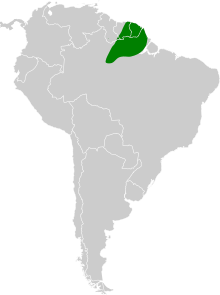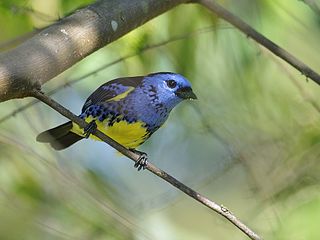
The turquoise tanager is a medium-sized passerine bird in the tanager family Thraupidae. It is a resident bird from Trinidad, much of Brazil, Colombia and Venezuela south to Bolivia. It is restricted to areas with humid forest, with its primary distribution being the Amazon. It was formerly treated as being conspecific with the white-bellied tanager which is found in the Atlantic Forest of eastern Brazil.
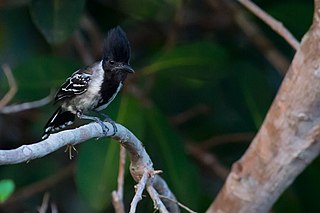
The black-crested antshrike is a passerine bird in subfamily Thamnophilinae of family Thamnophilidae, the "typical antbirds". It is found in tropical South America in Trinidad, Colombia, Venezuela, the Guianas, Brazil, and Peru.

The blue-headed parrot, also known as the blue-headed pionus is a medium-sized parrot of about 27 cm (11 in) in length. The body is mostly green, with a blue head and neck, and red undertail coverts. It is a resident in tropical and subtropical South America and southern Central America, from Costa Rica, Venezuela and the Caribbean island of Trinidad south to Bolivia and Brazil.

The red-capped cardinal is a small species of bird in the tanager family Thraupidae. It is found in South America.

The collared puffbird is a species of bird in the family Bucconidae, the puffbirds, nunlets, and nunbirds. It is found in Bolivia, Brazil, Colombia, Ecuador, French Guiana, Guyana, Peru, Suriname, and Venezuela.

The red-rumped cacique is a species of bird in the family Icteridae. It is a species of the Amazon Basin and the Guyanas in northern South America, and is only coastal there in the Guyanas and the Amazon River outlet to the Atlantic; a separate large disjunct range exists in all of south-eastern and coastal Brazil, including Paraguay, and parts of north-eastern Argentina. It is also found in Bolivia, Brazil, Colombia, Ecuador, French Guiana, Guyana, Peru, Suriname, and Venezuela.

The chestnut-belted gnateater is a species of bird in the family Conopophagidae, the gnateaters. It is found in the Amazon Basin of northern Brazil, southern Colombia and eastern Peru and Ecuador; also the Guianan countries of Guyana, Suriname and eastern French Guiana. Its natural habitat is tropical moist lowland forest.

The white-throated manakin is a species of bird in the family Pipridae. It is found in Brazil, French Guiana, Guyana, Suriname, and Venezuela. Its natural habitat is subtropical or tropical moist lowland forest.
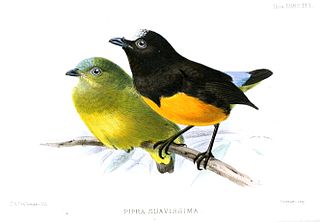
The orange-bellied manakin, also known as the tepui manakin, is a species of bird in the family Pipridae. It resembles and is closely related to the white-fronted manakin, and the two were formerly considered conspecific.

The whiskered myiobius or bearded flycatcher is a species of bird in the family Tityridae, having previously been included in Tyrannidae. A number of taxonomic authorities continue to place with the flycatchers. The whiskered myiobius is found in Brazil, Colombia, Ecuador, French Guiana, Guyana, Peru, Suriname, and Venezuela. Its natural habitats are subtropical or tropical moist lowland forests and heavily degraded former forest.

The Guianan red cotinga is a species of bird in the family Cotingidae, the cotingas. It is one of two species in the genus Phoenicircus.

The purple-throated fruitcrow is a species of bird in the family Cotingidae, the cotingas. It is the only species of the genus Querula. It is native to Nicaragua, Costa Rica, Panama, and most of the northern half of South America, its habitat being humid lowland forest where it feeds mainly on insects and fruit. It is a glossy black, medium-sized bird and the male has a purple-red throat patch. It nests in close vicinity with other birds of its species. Its population is in decline, but it is a common species with a very wide range, and the International Union for Conservation of Nature has assessed its conservation status as being of "least concern".

The flame-crested tanager is a species of bird in the family Thraupidae. It is found in Bolivia, Brazil, Colombia, Ecuador, French Guiana, Guyana, Peru, Suriname, and Venezuela. Its natural habitats are subtropical or tropical moist lowland forests and subtropical or tropical dry shrubland. Ten subspecies are currently recognized.

The fulvous-crested tanager is a species of bird in the family Thraupidae, the tanagers.
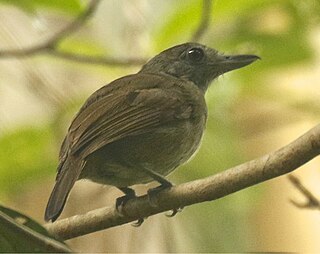
The mouse-colored antshrike is a species of bird in subfamily Thamnophilinae of family Thamnophilidae, the "typical antbirds". It is found in Bolivia, Brazil, Colombia, Ecuador, French Guiana, Guyana, Peru, Suriname, and Venezuela.
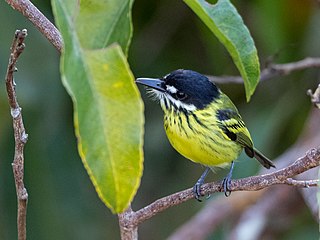
The painted tody-flycatcher is a species of bird in the family Tyrannidae, the tyrant flycatchers. It is found in the Guianas of French Guiana, Guyana and Suriname; also eastern-southeastern Venezuela and the northeastern states of Brazil of the Amazon Basin.
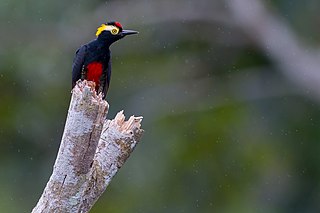
The yellow-tufted woodpecker is a species of woodpecker. It is found in Bolivia, Brazil, Colombia, Ecuador, French Guiana, Guyana, Peru, Suriname, and Venezuela. Its natural habitats are subtropical or tropical moist lowland forests and heavily degraded former forest.

The golden-spangled piculet is a species of bird in subfamily Picumninae of the woodpecker family Picidae. It is found in Brazil, Colombia, French Guiana, Guyana, Suriname, and Venezuela.

The Guianan moist forests (NT0125) is an ecoregion in the east of Venezuela, north of Brazil and the Guyanas. It is in the Amazon biome. The climate is hot and humid, with two rainy seasons each year. As of 1996 the tropical rainforest habitat was relatively intact, although there were mounting threats from illegal logging and gold mining.

